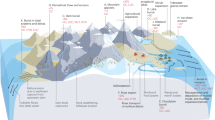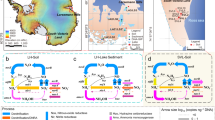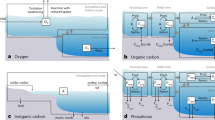Abstract
The bioavailability of essential nutrients such as nitrogen and phosphorus has fluctuated with the chemical evolution of Earth surface environments over geological timescales. However, significant uncertainty remains over the evolution of Earth’s early nitrogen cycle, particularly how and when it responded to the evolution of oxygenic photosynthesis. Here we apply multi-proxy geochemical analyses (Fe speciation, δ13C and δ15N) to exceptionally well-preserved shales from the approximately 2.7 billion year old Manjeri Formation in the Belingwe Greenstone Belt, Zimbabwe, to evaluate the redox status of Earth’s early nitrogen cycle and decipher feedbacks associated with the initial stages of planetary oxygenation. These continental shelf sediments were previously linked to early cyanobacterial oxygen production, and provide a direct test of conflicting hypotheses concerning the importance of nitrogen oxyanions in the Late Archaean era. Our data reveal a dominantly anaerobic marine nitrogen cycle in which ammonium-replete ferruginous waters underlay an ephemeral oxygen oasis. Driven by the emergence of oxygenic photosynthesis, increased primary productivity could have periodically strengthened export production, which allowed for the accumulation of ammonium in the water column during organic matter degradation. Restricted oxygen availability could have allowed the upwelling ammonium to reach the photic zone to provide ample nitrogen to fuel a prolific Late Archaean biosphere.
This is a preview of subscription content, access via your institution
Access options
Access Nature and 54 other Nature Portfolio journals
Get Nature+, our best-value online-access subscription
$29.99 / 30 days
cancel any time
Subscribe to this journal
Receive 12 print issues and online access
$259.00 per year
only $21.58 per issue
Buy this article
- Purchase on Springer Link
- Instant access to full article PDF
Prices may be subject to local taxes which are calculated during checkout


Similar content being viewed by others
Data availability
The authors declare that all data supporting the findings of this study are available within the article and its supplementary information files.
References
Galloway, J. N. in Biogeochem istry (eds Karl, D. M. and Schlesinger, W. H.) 475–498 (Elsevier, 2014).
Navarro-Gonzalez, R., McKay, C. P. & Mvondo, D. N. A possible nitrogen crisis for Archaean life due to reduced nitrogen fixation by lightning. Nature 412, 61–64 (2001).
Stüeken, E. E., Buick, R., Guy, B. & Koehler, M. C. Isotopic evidence for biological nitrogen fixation by Mo-nitrogenase from 3.2 Gyr. Nature 520, 666–669 (2015).
Weiss, M. C. et al. The physiology and habitat of the last universal common ancestor. Nat. Microbiol. 1, 16116 (2016).
Dalsgaard, T., Thamdrup, B., Farias, L. & Revsbech, N. P. Anammox and denitrification in the oxygen minimum zone of the eastern South Pacific. Limnol. Oceanogr. 57, 1331–1346 (2012).
Zerkle, A. L. et al. Onset of the aerobic nitrogen cycle during the Great Oxidation Event. Nature 542, 465–467 (2017).
Luo, G. et al. Rapid oxygenation of Earth’s atmosphere 2.33 billion years ago. Sci. Adv. 2, e1600134 (2016).
Baursachs, T. et al. Nitrogen isotopic fractionation associated with growth on dinitrogen gas and nitrate by cyanobacteria. Limnol. Oceanogr. 54, 1403–1411 (2009).
Zhang, X., Sigman, D. M., Morel, F. M. M. & Kraepiel, A. M. L. Nitrogen isotope fractionation by alternative nitrogenases and past ocean anoxia. Proc. Natl Acad. Sci. USA 111, 4782–4787 (2014).
Zhang, X. et al. Alternative nitrogenase activity in the environment and nitrogen cycle implications. Biogeochemistry 127, 189–198 (2016).
Boyd, E. S. & Peters, J. W. New insights into the evolutionary history of biological nitrogen fixation. Front. Microbiol. 4, 201 (2013).
Hoch, M. P., Fogel, M. L. & Kirchman, D. L. Isotope fractionation associated with ammonium uptake by a marine bacterium. Limnol. Oceanogr. 37, 1447–1459 (1992).
Sigman, D. M., Karsh, K. L. & Casciotti, K. L. in Encyclopedia of Oce an Sciences (eds Steele, J. H., Thorpe, S. A. & Turekian, K. K.) 40–54 (Academic, 2009).
Brunner, B. et al. Nitrogen isotope effects induced by anammox bacteria. Proc. Natl Acad. Sci. USA 110, 18994–18999 (2013).
De Pol-Holz, R., Robinson, R. S., Hebbeln, D., Sigman, D. M. & Ulloa, O. Controls on sedimentary nitrogen isotopes along the Chile margin. Deep-Sea Res. Part II 56, 1100–1112 (2009).
Kipp, M. A., Stüeken, E. E., Yun, M., Bekker, A. & Buick, R. Pervasive aerobic nitrogen cycling in the surface ocean across the Paleoproterozoic era. Earth Planet. Sci. Lett. 500, 117–126 (2018).
Garvin, J., Buick, R., Anbar, A. D., Arnold, G. L. & Kaufman, A. J. Isotopic evidence for an aerobic nitrogen cycle in the latest Archaean. Science 323, 1045–1048 (2009).
Godfrey, L. V. & Falkowski, P. G. The cycling and redox state of nitrogen in the Archaean ocean. Nat. Geosci. 2, 275–279 (2009).
Bolhar, R., Hofmann, A., Woodhead, J., Hergt, J. & Dirks, P. Pb- and Nd-isotope systematics of stromatolitic limestones from the 2.7 Ga Ngezi Group of the Belingwe Greenstone Belt: constraints on timing of deposition and provenance. Precambrian Res. 114, 277–294 (2002).
Grassineau, N. V., Abell, P., Appel, P. W. U., Lowry, D. & Nisbet, E. G. Early life signatures in sulfur and carbon isotopes from Isua, Barberton, Wabigoon (Steep Rock) and Belingwe Greenstone Belts (3.8 to 2.7 Ga). Geol. Soc. Am. Mem. 198, 33–52 (2006).
Abell, P. I., McClory, J., Martin, A. & Nisbet, E. G. Archaean stromatolites from the Ngesi Group, Belingwe Greenstone Belt, Zimbabwe; preservation and stable isotopes—preliminary results. Precambrian Res. 27, 357–383 (1985).
Nisbet, E. G. et al. Uniquely fresh 2.7 Ga komatiites from the Belingwe greenstone belt, Zimbabwe. Geology 15, 1147–1150 (1987).
Stüeken, E. E., Zaloumis, J., Meixnerova, J. & Buick, R. Differential metamorphic effects on nitrogen isotopes in kerogen extracts and bulk rocks. Geochim. Cosmochim. Acta 217, 80–94 (2017).
Poulton, S. W. & Canfield, D. E. Development of a sequential extraction procedure for iron: implications for iron partitioning in continentally derived particulates. Chem. Geol. 214, 209–221 (2005).
Eickmann, B. Isotopic evidence for oxygenated Mesoarchean shallow oceans. Nat. Geosci. 11, 133–138 (2018).
Habicht, K. S. & Canfield, D. E. Sulfur isotope fractionation during bacterial sulfate reduction in organic-rich sediments. Geochim. Cosmochim. Acta 61, 5351–5361 (1997).
Thomazo, C., Grassineau, N. V., Nisbet, E. G., Peters, M. & Strauss, H. Multiple sulfur and carbon isotope composition of sediments from the Belingwe Greenstone Belt (Zimbabwe): a biogenic methane regulation on mass independent fractionation of sulfur during the Neoarchean? Geochim. Cosmochim. Acta 121, 120–138 (2013).
Thomazo, C., Ader, M. & Philippot, P. Extreme 15N-enrichments in 2.72-Gyr-old sediments: evidence for a turning point in the nitrogen cycle. Geobiology 9, 107–120 (2011).
Stüeken, E. E., Buick, R. & Schauer, A. J. Nitrogen isotope evidence for alkaline lakes on late Archaean continents. Earth Planet. Sci. Lett. 411, 1–10 (2015).
Derry, L. A. Causes and consequences of mid-Proterozoic anoxia. Geophys. Res. Lett. 42, 8538–8546 (2015).
Reinhard, C. T. et al. The evolution of the global phosphorus cycle. Nature 467, 1088–1090 (2016).
Izon, G. et al. Biological regulation of atmospheric chemistry en route to planetary oxygenation. Proc. Natl Acad. Sci. USA 114, 2571–2579 (2017).
Canfield, D. E., Raiswell, R., Westrich, J. T., Reaves, C. M. & Berner, R. A. The use of chromium reduction in the analysis of reduced inorganic sulfur in sediments and shales. Chem. Geol. 54, 149–155 (1986).
Mettam, C. et al. High-frequency fluctuations in redox conditions during the latest Permian mass extinction. Palaeogeogr. Palaeoclimatol. Palaeoecol. 485, 210–223 (2017).
Clarkson, M. O., Poulton, S. W., Guilbaud, R. & Wood, R. A. Assessing the utility of Fe/Al and the Fe-speciation to record water column redox conditions in carbonate-rich sediments. Chem. Geol. 382, 111–122 (2014).
Slotznick, S. P., Eiler, J. M. & Fischer, W. W. The effect of metamorphism on iron mineralogy and the iron speciation redox proxy. Geochim. Cosmochim. Acta 224, 96–115 (2018).
Grassineau, N. V. High-precision EA-IRMS analysis of S and C isotopes in geological materials. Appl. Geochem. 21, 756–765 (2006).
Coplen, T. B. et al. New guidelines for delta C-13 measurements. Anal. Chem. 78, 2439–2441 (2006).
Polissar, P. J., Fulton, J. M., Junium, C. K., Turich, C. H. & Freeman, K. H. Measurement of 13C and 15N isotopic composition on nanomolar quantities of C and N. Anal. Chem. 81, 755–763 (2009).
Acknowledgements
This study was supported financially by Natural Environment Research Council Standard Grants NE/M001156/1 (A.L.Z., E.G.N. and N.V.G.) and NE/J023485/2 (A.L.Z.), and the National Science Foundation NSF EAR-1455258 (C.K.J.). G.I. acknowledges continued support from the Simons Foundation (SCOL:290361) during the final drafts of the manuscript. The authors thank M. Hunter for help in logging the NERCMAR core, D. Herd for assistance with petrography, A. Calder for assistance with X-ray fluorescence analyses, A. Prave for thought-provoking discussion on the Manjeri Formation strata, and T. Laakso, C. Thomazo and M. Ader for constructive comments on previous versions of the manuscript.
Author information
Authors and Affiliations
Contributions
A.L.Z. and E.G.N. conceived the study; J.Y., N.V.G., E.G.N. and A.M. collected the samples; J.Y., C.K.J., N.V.G., G.I. and C.M. processed the samples and performed geochemical analyses; J.Y., A.L.Z. and C.K.J. interpreted the data and wrote the manuscript with input from all the co-authors.
Corresponding author
Ethics declarations
Competing interests
The authors declare no competing interests.
Additional information
Publisher’s note: Springer Nature remains neutral with regard to jurisdictional claims in published maps and institutional affiliations.
Supplementary information
Supplementary Information
Supplementary sample information; Supplementary Figs. 1–5 and Supplementary Tables 1–3.
Rights and permissions
About this article
Cite this article
Yang, J., Junium, C.K., Grassineau, N.V. et al. Ammonium availability in the Late Archaean nitrogen cycle. Nat. Geosci. 12, 553–557 (2019). https://doi.org/10.1038/s41561-019-0371-1
Received:
Accepted:
Published:
Issue Date:
DOI: https://doi.org/10.1038/s41561-019-0371-1
This article is cited by
-
Modern analogs for ammonia flux from terrestrial hydrothermal features to the Archean atmosphere
Scientific Reports (2024)
-
Isotopic constraints on lightning as a source of fixed nitrogen in Earth’s early biosphere
Nature Geoscience (2023)
-
Phanerozoic radiation of ammonia oxidizing bacteria
Scientific Reports (2021)
-
The Isotopic Imprint of Life on an Evolving Planet
Space Science Reviews (2020)



